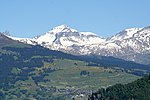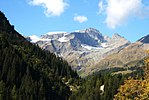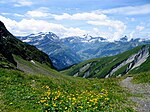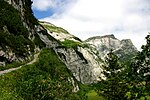Tschingelhörner
Canton of Glarus geography stubsFlimsGlarus–Graubünden borderGraubünden mountain stubsMountains of Graubünden ... and 6 more
Mountains of SwitzerlandMountains of the AlpsMountains of the canton of GlarusSwitzerland mountain stubsTwo-thousanders of SwitzerlandWorld Heritage Sites in Switzerland

The Tschingelhörner (also spelled Tschingelhoren) are a chain of mountain peaks in the Glarus Alps, located on the border between the Swiss cantons of Glarus and Graubünden. They are composed of several summits on a 1 km (0.62 mi) long ridge, of which the highest is named Grosses Tschingelhorn (2,849 m). The mountain is located between Elm and Flims, west of the Segnas Pass (2,627 m). East of the main summit is the Martinsloch, a 6-by-18-metre (20-by-60 ft) triangular breakthrough, or hole, through which the sun shines at particular times of the year. The mountain is part of the Swiss Tectonic Arena Sardona and is a UNESCO World Heritage Site.
Excerpt from the Wikipedia article Tschingelhörner (License: CC BY-SA 3.0, Authors, Images).Tschingelhörner
Rundeweg Segnesboden,
Geographical coordinates (GPS) Address Nearby Places Show on map
Geographical coordinates (GPS)
| Latitude | Longitude |
|---|---|
| N 46.898277777778 ° | E 9.2213333333333 ° |
Address
Martinsloch
Rundeweg Segnesboden
Grisons, Switzerland
Open on Google Maps











